Izbica
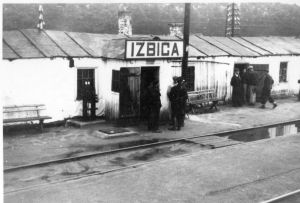
Izbica Railway Station
Izbica (Nad Wieprzem) is located 36 miles south-east of Lublin. The last census taken before the Second World War recorded around 4,500 Jews living in this typical Jewish shtetl. The Germans first occupied Izbica on 15 September 1939 and immediately on entering Izbica, they seized goods from Jewish shops as a ‘tribute.’ After a few days, the German army withdrew, permitting the Soviet army to occupy part of the Lublin region for several days. The Jewish residents of Izbica welcomed the Soviets as liberators. But this was short-lived, on 28 September 1939, the Soviet army retreated under the terms of the Nazi-Soviet agreement. Some Jewish residents, mainly young men, left with the Soviet army. In the brief period after the Soviets left and before the Germans returned, a group of local Poles threw stones at some Jews who had allegedly collaborated with the Soviets, killing one person and wounding several others.
By early October 1939, the German forces again had occupied Izbica. Another wave of looting ensued, in which the Jews were especially badly affected. At the end of 1939, the German authorities prohibited the Jews from engaging in trade and also from leaving the town to barter with the surrounding population. Nevertheless, an illicit trade continued between Jews and Christians. Since Jewish children under the age of 14 were not required to wear white armbands bearing the Star of David, they sneaked out to exchange goods and personal possessions for food. From the end of 1939, the Germans began resettling Jews into Izbica from Polish towns further to the west that had been incorporated into the Third Reich, including Kolo, Kalisz, and Lodz. In March 1941, more than 1,000 Jews from Kreis Konin were deported via Lodz, to Izbica.
By August 1941, approximately 7,000 Jews were living in Izbica, including nearly 2,000 refugees. At the start of 1940, a Jewish Council (Judenrat) was formed in Izbica. Abraham Blatt was appointed as its head, and his deputy was a merchant named Schneidermesser. Other members of the Judenrat were Mosser Sznajd, Milsztajn, Zylberberg, Bron, and Klajner. In the view of some Jews who survived, chairman Blatt and his deputy Schneidermesser collaborated with the occupying authorities rather too eagerly. At first, the main task of the Judenrat in Izbica was to select people for labour, so its members put together a list of able-bodied men and women. Assisted by the Judenrat, the Germans established a unit of Jewish Police (Judischer Ordnungsdienst), which at its inception had 40 members. In November 1939, the Nazis installed a civil administration in Izbica. Its local representative was the ethnic German Johann (Jan) Schulz, who had been an assistant to a Jewish watchmaker before the war. From the start he issued a series of regulations severely restricting the rights of Jews and Poles.
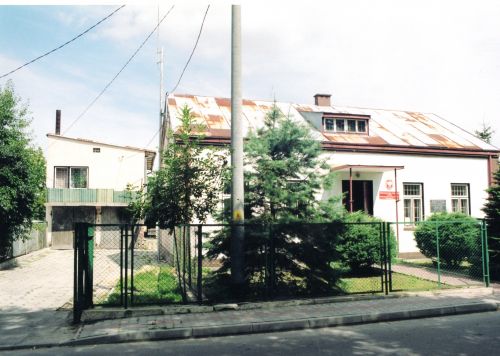
Izbica - Gestapo Post 2004
At the end of 1940, a Sicherheitsdienst (SD) detachment was established in Izbica, headed by Kurt Engels; his deputy was Ludwik Klemm. The detachment served the entire Kreis Krasnystaw, arresting and carrying out other punitive measures against Jews and Poles. Besides the Judenrat, the Jewish Social Self-Help (JSS) organisation also functioned in Izbica. It managed a communal kitchen and a makeshift Jewish hospital, which was located in the synagogue. The hospital had to serve the entire Kreis Krasnystaw, but was only capable of treating approximately 40 patients at a time. From the start of the German occupation, Jews were forced to perform heavy labour in the town. The tasks included street cleaning. In the spring of 1940, a few hundred Jews were sent off to labour camps located within the Lublin District. Some went to Szczepanow, others to Ruda-Opalin, near Chelm. The largest group was deported to Belzec, the largest forced labour camps complex, who were engaged in digging trenches on the German-Soviet border. The last wave of Polish Jews who were resettled into Izbica came in March and April 1941, when the Germans resettled approximately 1,000 people from the city of Lublin. A closed ghetto did not exist at this time. However, Jews were not allowed to leave the designated borders of the town, and this meant the entire town resembled a large ‘open ghetto.’ It was bordered on three sides by hills and, on the fourth – Tarnogor side, by the Wieprz River. Jews could not even move freely within the town. However, Izbica was not listed as a ghetto in the report of Kreishauptmann Schmidt to District –level authorities in September 1941, although it was clearly viewed as a Judenstadt by the German authorities. Despite the restrictions, a few Jewish groups carried on clandestine exchanges of goods with the help of Poles, for example at a local tannery where the Jews prepared hides for sale. At the end of 1941 early 1942, the Germans confiscated furs from the Jews in Izbica, for the German army on the eastern front. After the Wannsee Conference in Berlin in January 1942, Izbica became the initial destination for the Jews deported from the Protectorate of Bohemia and Moravia, mainly from Theresienstadt ghetto, Germany, Austria and Slovakia. The choice of Izbica reflected its location on the main line between Lublin and Belzec, where the Nazis started construction of the first death at Belzec in November 1941, and which became operational in March 1942. The first transport to Izbica arrived on 13 March1942; it carried 1,001 Czech Jews who had been deported from Theresienstadt. In all there were 16 transports between 13 March 1942 until 5 June 1942, from Theresienstadt, Aachen, Bamberg, Nurnberg, Dusseldorf, Frankfurt, Wurzburg, and other German cities, also from Vienna, Austria and Slovakia. The new arrivals had to wait for available places to stay, and in the ghetto there was incredible overcrowding. Living and especially hygiene conditions quickly became appalling. The deportees suffered severely from hunger. Not until the summer of 1942, when Jews were being sent to the death camps, did the authorities provide rations for the Jews. The JSS proved inadequate to the task. The majority of the deportees were women, children or the elderly. Many of them had left their possessions behind and had nothing to live on in Izbica. Death from starvation and exhaustion occurred daily. Only a few people were more fortunate, managing to obtain food and work on estates in Tarnogor or in the labour camps close to Izbica at Augustowka and Bzite. Cultural conflicts were common between the Polish Jews and the Jews who arrived in Izbica from other countries. A majority of the non-Polish Jews were assimilated, had liberal attitudes towards religion and tradition, and did not speak Yiddish. The conflict was exploited and deepened by the Germans who deliberately set the groups against each other. In 1942, they set up one Judenrat for the Polish Jews and one for the Jews transported to Izbica. Only the members of the non-Polish Judenrat are known: Dr A. Lob Pauner, Ludwig Wienheber, Dr Nathan Rosenthal, and Hugo Kolb. Separate branches of the JSS were established. During the course of the various ‘Aktions’ the non-Polish Jewish policemen arrested Polish Jews and vice versa.
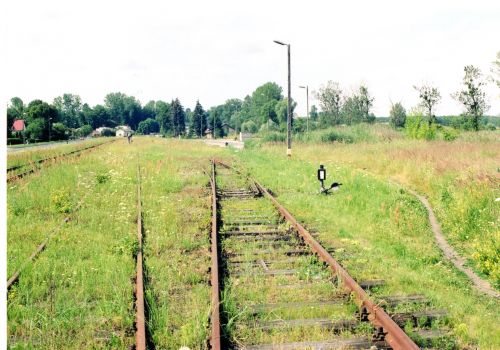
Izbica - Jewish Deportation Area -2004
The first deportation ‘Aktion’ in Izbica took place on 24 March 1942. Approximately 2,200 Polish Jews were deported to the death camp at Belzec. Several dozen Jews were also shot on the spot, mainly by the local SS officers Kurt Engels and Ludwik Klemm. The bodies of those who were shot were taken to the Jewish cemetery and buried there. The deportations were supervised by officers from the SS Training camp in Trawniki and by the Gendarmarie from Krasnystaw, with the assistance of the Polish (Blue) police. The next ‘Aktion’ took place on 12 – 15 May 1942, as part of a mass deportation for ‘Kreis Krasnystaw.’ First, several hundred Jewish men – both Polish and non-Polish – were taken from Izbica to the concentration camp in Lublin. A second group consisting of approximately 400 people was deported to the death camp in Sobibor. After a short time, the Polish Jews began to comprehend the fate of the deportees to Belzec.
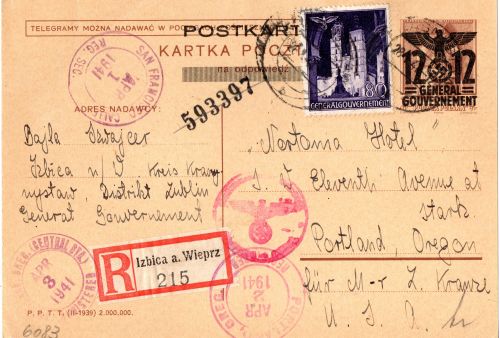
Postcard from Izbica to Portland USA - April 1941 (Chris Webb Private Archive)
During subsequent ‘Aktions,’ many people tried to escape and hide in Izbica or in the nearby forests. Most of the non-Polish Jews at this time obediently assembled on the Izbica market place, then were led away in columns to the Izbica railway station. These Jews recognised more slowly the fate that awaited them. On 8 June 1942, another deportation ‘Aktion’ took place, this time directed against those deemed unfit for work. There were many Jews in Izbica who fell into this category. Approximately 2,000 Polish and non-Polish were deported, probably to Belzec death camp. On 6-7 July 1942, the Germans rounded up Jews found hiding in Izbica and on 8 July 1942, another deportation took place to the Sobibor death camp. From mid-July until the autumn of 1942, the situation in Izbica was relatively calm. No further deportations were carried out. But within the town, mainly in the meadows and in the area where the Jewish cemetery was located, Jews were arrested and executed, on the personal orders of Engels and Klemm. The executions were carried out on the grounds that Jews were trading illegally, having contact with Poles, storing weapons, or corresponding with co-religionists. This last accusation was commonly made against the non-Polish Jews after May 1942. An example of such clandestine correspondence is the letter dated 22-23 August 1942 sent by Ernst Krombach, who was deported from Dusseldorf to Izbica on 22 April 1942, to his fiancée back in Germany. This letter which was not censored provides a frank and detailed description of life in Izbica: Everything is forbidden, the penalty as above (death). Leaving the ordained district before 7.00 a.m. or after 7 p.m. Battering, buying or selling or speaking to Polish Aryans.... Sending letters or other messages...... Leaving the city limits. Many transports have left here. Of the approximately 14,000 Jews who arrived, only 2,000 to 3,000 are still here. They go off in cattle trucks, subject to the most brutal treatment. Even though these deportations had by then ceased for a while, things were not all rosy or calm. We have become used to shootings. No week goes by without something happening: evacuation, round-ups of people on the street for work in the vicimity, visits from outside SS, house searches, confiscation of particular items. Regarding living conditions, hygiene is a joke. Everything is filthy, lice- particularly clothes lice – that spread typhus, fleas, bugs,. There are few latrines. Sewage flows through unpaved streets (stench, illness. The last wave of forced resettlements into Izbica took place in the autumn of 1942.
Starting in October 1942, and continuing in November 1942, Izbica became the central ghetto for Polish Jews in ‘Kreis Krasnystaw’. Several thousand Jews were brought to Izbica from Krasnystaw, Zolkiewka, and Turobin and also from places within the Zamosc district. The last Jews from Zamosc and Krasnobod were driven to Izbica on foot. It is not known exactly how many Jews were in Izbica at this time, but it is estimated that approximately 6,000 Jews came to Izbica from the surrounding towns and villages. On 19 October 1942, more than 5,000 Jews were deported from Izbica in the largest of the resettlement ‘Aktions’ The deportation was directed by the Security Police from Izbica, Zamosc and Lublin. The German civil administration from Krasnystaw also took part. The Germans used the Polish (Blue) police to round up the Jews. The policemen received monetary rewards for finding Jews in hiding. This ‘Aktion’ was particularly bloody. At least 500 Jews were shot on the platform of the railway station in Izbica. The Germans liquidated the orphanage in Izbica by shooting all the children there. The Jews were deported to the Sobibor death camp. During the ‘Aktion’ many Jews escaped from Izbica, hiding in the nearby fields. Afterwards they returned and fell into the German trap. On 2 November 1942, more than 4,000 Jews were deported to Belzec and Sobibor death camps. The trains for the deportations shuttled back and forth nonstop. Those for whom there was no space in the cattle trucks, or who were in hiding and captured, they were taken into the local fire brigade building. After a few days they were taken to the Jewish cemetery where under the supervision of Kurt Engels, they were shot. More than 1,000 Jews were killed in this fashion.
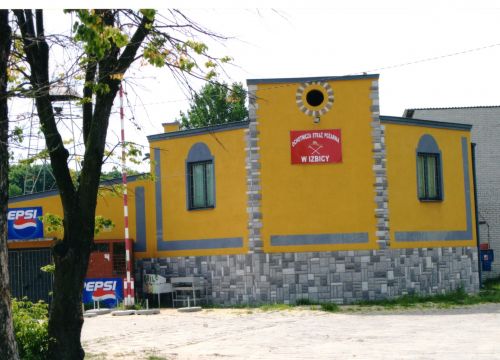
Izbica Fire Station 2004
At the end of this ‘Aktion,’ Engels personally shot the chairman of the Judenrat, Abraham Blatt, and his deputy Schneidermesser. On 28 October 1942, the Higher SS and Police Leader in the General Gouvernement Friedrich Wilhelm Krüger, ordered the creation of a ‘remnant ghetto’ in Izbica. All those Jews who had managed to survive the last deportation were collected in this ghetto, namely those found hiding in Izbica or in the nearby wooded areas and also Jews who had escaped from other ghettos. The ghetto consisted of several buildings near the Altmanow Tannery on Stokowa and Cicha Streets, near the former brick factory at Kulik Street. The ‘remnant ghetto’ was also an’ open ghetto,’ Jews worked there in the tannery and the brick factory. A new Judenrat was formed, and it was headed by Leon –Lejb Blatt and Tadeusz Cwekin. Its purpose was to attract Jews who were hiding elsewhere in the region. In January 1943, 700 Jews were deported from this ‘remnant ghetto’ to the Sobibor death camp. The final liquidation of the ghetto took place on 28 April 1943, when the last 200 Jews, including Thomas ‘Toivi’ Blatt, were packed into trucks and driven to the Sobibor death camp. Between 1940 and early 1943, more than 20,000 Polish and non-Polish Jews passed through the Izbica ghetto. From Izbica itself, a mere 14 Jews managed to survive the war. Although Kurt Engels and Ludwik Klemm were arrested, they were never tried. Following their arrests, in Hamburg and Limburg, respectively, they both committed suicide.
Sources:
The Encyclopaedia of Camps and Ghettos 1933-1945,
Y. Arad, Belzec, Sobibor, Treblinka – The Aktion Reinhard Death Camps, Indiana University Press, Bloomington and Indianapolis 1987
R.Kuwalek, From Lublin to Belzec, AD Rem, Lublin, 2006
www. Bundesarchiv.de Gedenkbuch
Photograph – Tall Trees Archive
Postcard - Chris Webb Private Archive
Photographs Chris Webb Archives
© Holocaust Historical Society 2018

